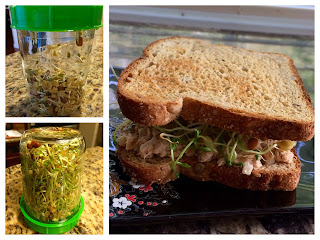I love to add sprouts to sandwiches or salads, but they can be a bit pricey at the grocery store, and aren't always very fresh. I started growing my own, and discovered it is really easy. Another big advantage of growing your own is the great variety available, not just the plain jane alfalfa sprouts most commonly found when grocery shopping. I like the finer seeds, such as radish, broccoli, red clover, alfalfa, etc. and Kayte prefers the chunkier seeds like lentils and beans. Although the seeds can seem expensive at first, they make a lot of sprouts and go a long way. Of course, the other advantage is that you know just how fresh they are and that they haven't been contaminated during the growing or processing period.
All you need to get started is a jar, lids with holes (for draining) and some seeds. Amazon has a great starter kit of lids that fit wide-mouth Mason jars. I ordered the sampler pack of sprouting seeds (also on Amazon), and it is a great way to try a large variety of different mixes. I shared it with Kayte, and that is how we discovered we have distinctly different preferences. There are lots of other sources for seeds, and you may be able to find some at local health food stores. Be sure you are buying seeds made specifically for sprouting, and not for planting. Seeds for planting are often treated with fungicides or other chemicals.
To start, add seeds to the jar, cover with cool water and let soak for 8 hours or overnight. I use a heaping tablespoon of small seeds in a pint jar, but you will need to add more seeds if you are using larger varieties. After soaking, drain off the liquid, then rinse twice with cool water. Drain well, and position jar so that any remaining water can continue to drain (the lids from Amazon allow you to put the jar upside down). Rinse twice with cool water morning and evening for the next several days until your sprouts are the size you want them. Mine usually take about 3-4 days, and I like to put them where they get plenty of light for the last day or so to become nice and green, but that isn't necessary. Store covered in the refrigerator when finished growing. (You can take a few out during the growing process and allow the rest to continue growing.)




0 comments:
Post a Comment